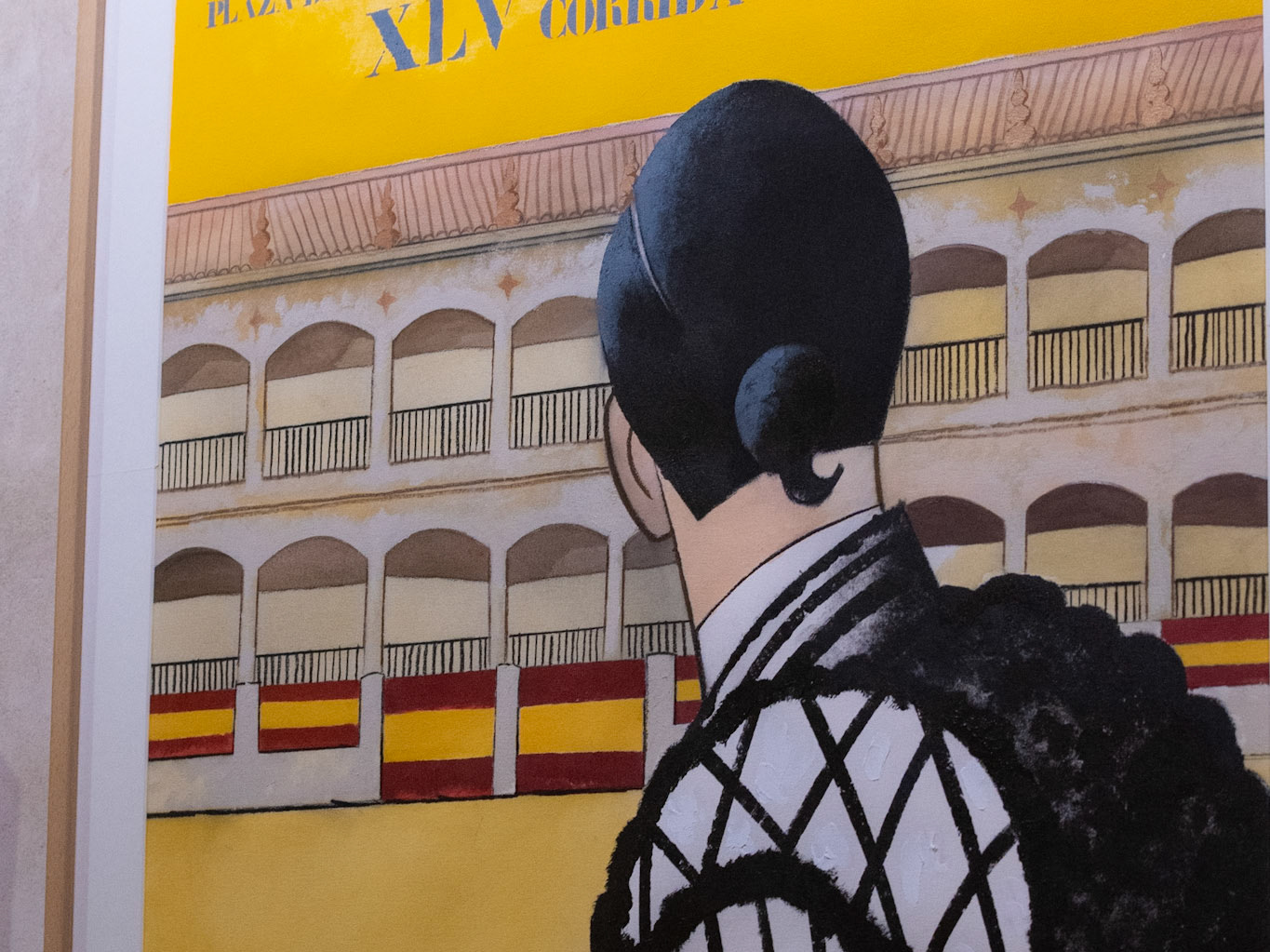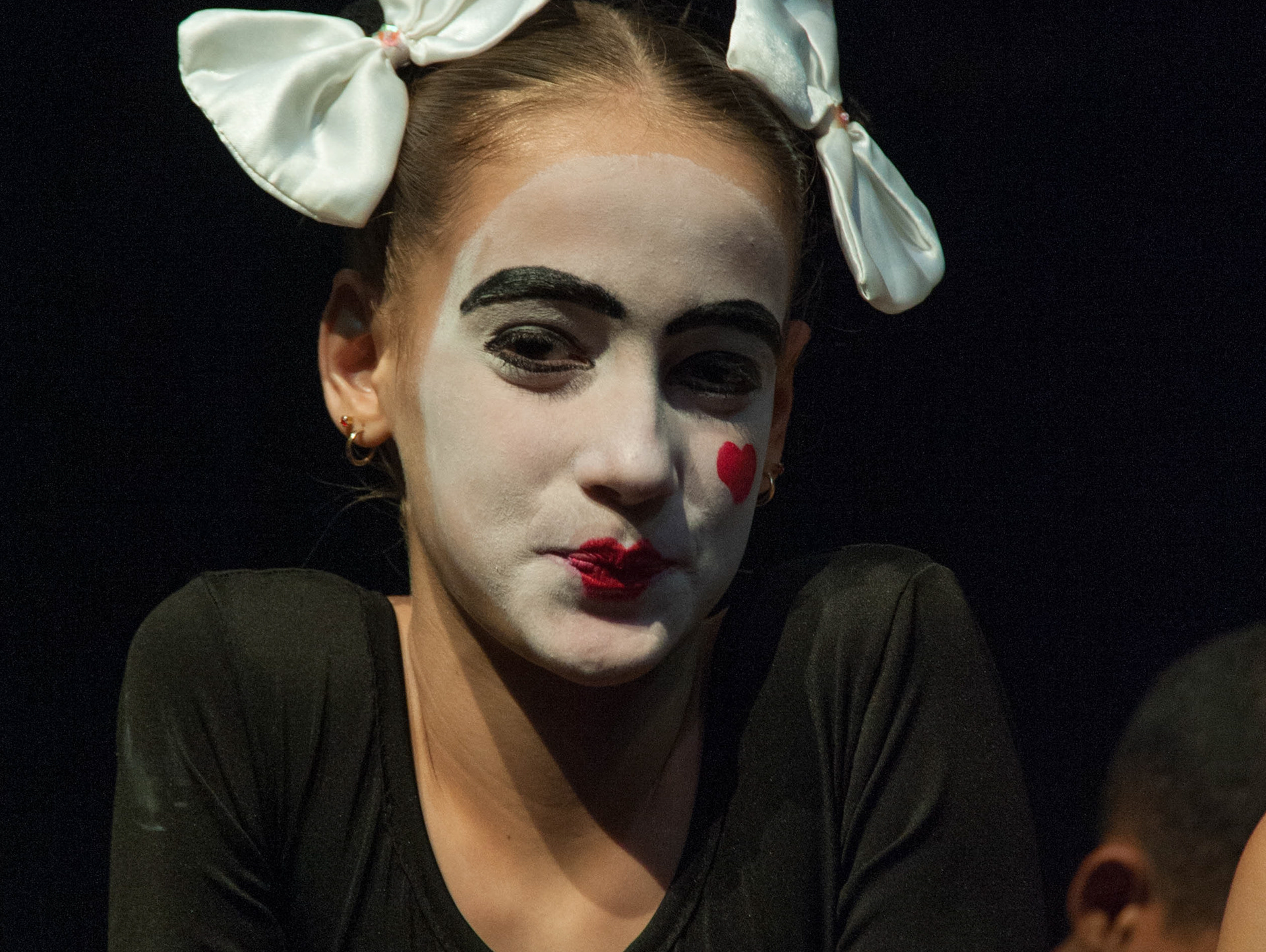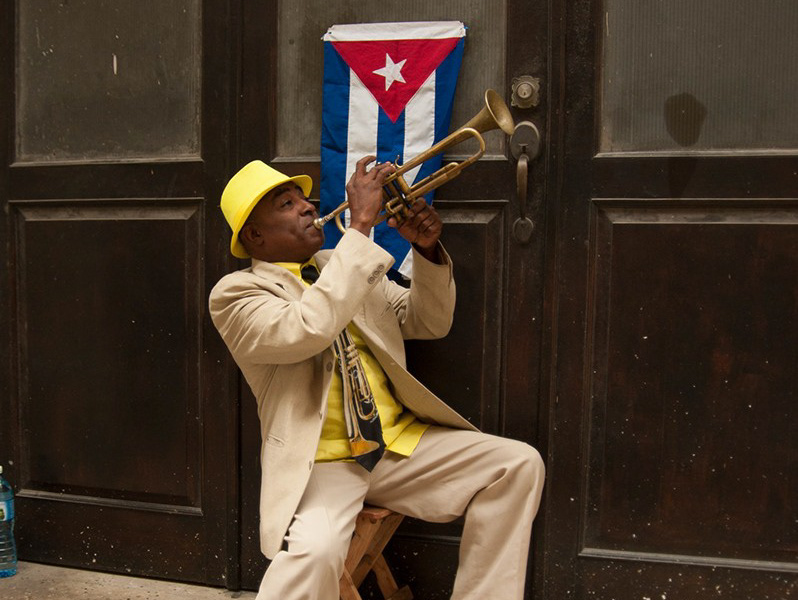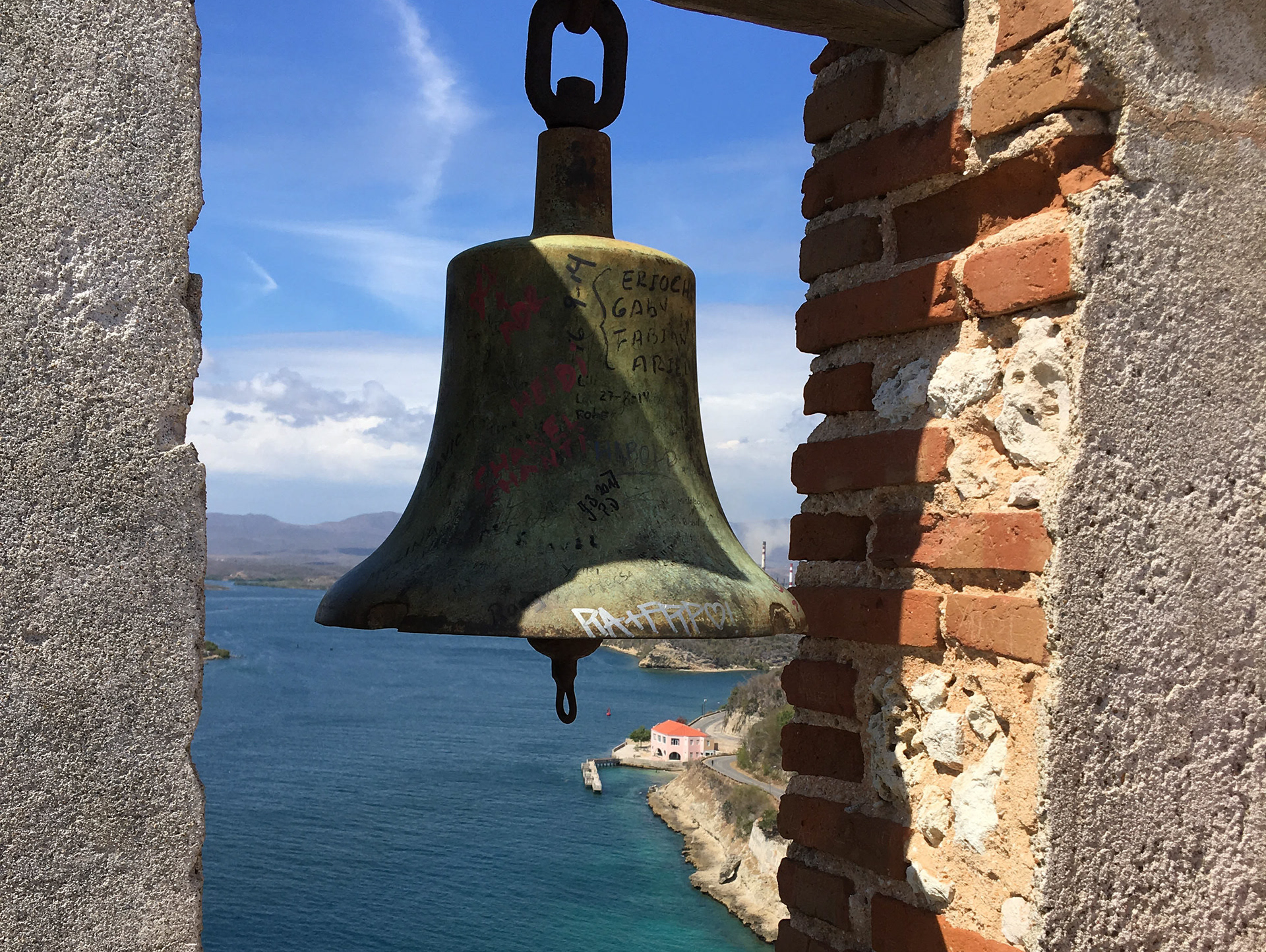Baracoa: The first European town in the New World (1591), a victim of repeated hurricane strikes, and geographic isolation resulting in both lessened outside influence over years and also becoming a biodiversity reserve.
Bus travel entailed a 5 hour ride from Santiago de Cuba, passing through Guantanamo province and city, traversing a mountain range on a technically challenging highway, and descending into the city of Baracoa. The city has been restored with remarkable speed only 5 months after Hurricane Matthew sent 10-16 foot waves through town, destroying much of its infrastructure. For news reports and a photo of the storm in Baracoa, follow http://www.miamiherald.com/news/nation-world/world/americas/cuba/article105956537.html
The guidebook recommended skipping Guantanamo city. Taken from a distance, this is apparently another Plaza Revolution....
...wall art on an apartment building.....
...and more statues of revolutionary heroes.
The tour bus stopped at a local hotel. All owned by the government, the busses, the hotels, and the tour company cooperate to supply restrooms to tourists. This is necessary because here most public restrooms lack toilet paper, toilet seats, and won't flush.
A map on the wall is worn from fingers indicating current position and the "territory occupied illegally by the United States of America". Our tour guide pointed out that the US occupation of Guantanamo Bay was not illegal but was agreed to by the Cubans (under pressure from the US Senate and Platt Amendment) immediately after the War of Independence in 1898. The US still writes annual checks for the agreed-upon rent of $4,000 per year, but for many years the Cuban government has refused to cash these.
A short distance further, our bus climbed a steep short grade up the mountain to a mountaintop rest area fitted with a high viewing platform. In the parking lot is a 1950 Ford tourist hauler. Yes, also a restroom, and a bar/barfood snack bar.
Looking south from the platform is Guantanamo Bay and scarcely visible buildings of the American Marine base.
Near the viewing platform, lovely flowering trees, tourist trinkets.
Continuing down the coastal road, it is hot and dry but the ocean is beautiful.
A Soviet-era truck loaded with tomatoes, a local bus, and a camione.
Starting up the mountain. Until this highway was constructed by Cuban engineers in the 1960's, the only land route into Baracoa from the rest of Cuba was negotiable by donkey. The road is curvy and clings precipitously to the sides of mountains as the tour bus shifts to low gear.
Towards the top vendors selling conical palm leaf containers of homemade sweets containing coconut, sugar, and fruits.
Beehives...source of the honey
As we mount the peak of the range....
...vegetation suddenly becomes more sparse. The hurricanes? Or dryness due to being on the opposite side of the mountain from the prevailing rainfall?
Fractured guardrail
Finally we head down
These handmade wooden carts were abundant on this mountain pass, but were not seen in use.
Deforestation and a washout.....
Fixing a Willys...
"Growing with the effort of all"
Another Willys. Hardly looks 60 years old...
Soviet truck, roof heavily rusted, and faded declaration: "All for my city"
A traffic jam of people-haulers...
Entering Baracoa...
"I'm 52 and I'm wrong."
The baseball stadium: "Multiplying reasons Baracoa grows"
Welcome: Baracoa was founded in 1591 by Diego Velazquez...(in the absence of laundry on the line, this and several of the last pictures would have had little color....)
Christopher Columbus....who landed at Baracoa in 1492, though there is some debate about this..
The Malecon..
This building has been restored since the storm.
Rebuilding after Hurricane Matthew...
A private B and B...
"Photo leader...the star of the image."
The main street on which the tour bus enters the city is well painted. A block away, not yet...
We debark at the hotel.
The hotel pool...
Looking across the bay. The building on the top of the mountain is the Fuerte de Seboruco. This has been turned into the Hotel Castillo, but it hasn't reopened since Hurricane Matthew.
The rusty hulk in the bay is part of a wrecked ship about which no one seems to have any further information.
In Baracoa the next morning, we are shown around by the town historian.
Parroquia Nuestra Señora de la Ascunsion houses the...
....Cruz de la Parra. Columbus supposedly planted this cross when he landed here in 1492. Carbon dating has confirmed its age but the wood species as one which is common in Baracoa and was therefore made after he landed. Others say Columbus landed further west on Cuba.
Hatuey, a Taino indian, led a rebellion against the Spanish in 1512, was captured and burned at the stake. It is said that just before his execution a Catholic priest tried to convert him to Christianity. Hearing of Heaven, the chief asked where the Spanish went when they died . Told "heaven", he said he preferred not to go where there were Spanish and would take the alternative. Ultiamtely, the Taino indians were eliminated from all the Caribbean Islands.
Cuyahoga Community College! We know where that is, we used to live in Cleveland. The person wearing the shirt had no idea what we were talking about and it wasn't clear he had any idea what the lettering on his shirt meant.
These pleasant young men are Sargent 3rd Class in the Revolutionary Armed Forces. With patches stating "Prevencion", they were patrolling the downtown area. Police and most military do not carry guns. We were warned that in general photographing police or military personnel is risky. I asked and was granted permission before taking the shot.
A local art gallery had many attractive pieces, including these images . Title "Believe in Brunettes," by Baracoan artist, Magalis Suarez Leiva.
Agricultural products of Baracoa include cacao (coco) and coconuts. This is the Chocolate House where a variety of chocolate products are available, including a wonderful cold chocolate drink.
Mural adjacent to the town square.
We were taken into the municipal museum nearby, located in one of the original forts, where we were shown these examples of biodiversity preserved in the very special biosphere which is Baracoa. These striped shells are found only here.
Similarly, we were shown a photo of this tiny toad again extant only in this area.
Not all that long ago, Ivory Billed Woodpeckers were sighted here. This species was long thought extinct by North American ornithologists.
We were taken into the nearby Cuchillas del Toa Biosphere Reserve, and given a brief boat ride up the Toa River. The National Geographic Traveller Guide Book says that the mountains near here are "among the least explored terrains in Cuba. The region's unique flora and fauna have evolved in isolation--a godsend for birders and hikers."
Near the mouth of the river, we were taken to a couple of small houses positioned within yards of the ocean. In one, we were introduced to a multigenerational family.
Glancing out back, we saw them butchering a pig....
..the ocean from the house....
The patriarch and matriarch. Both in their 90s, she is blind and he just stopped climbing the nearby coconut trees just a couple of years ago.
The neighbor stopped by and agreed to a photo.
On the way out of Baracoa the next morning we were told that we would meet an expert on cacao production as part of the region's preeminence in chocolate production. It was raining, and our bus stopped on a side road. The tour leader got out and went into a house. It soon became clear he was looking for the place where we were to have this meeting. At one point, he asked other neighbors who were out, and they directed us to another house. In this house, we met a person who we were told is considered a UNESCO world heritage person because of his encyclopedic knowledge of cacao. While all of this was taking place, we were looking around in the rain....
We found beautiful flowers....
...and a goat....
and finally the man himself.
All of this attracted the neighbors' attention.....
The house in which our lecture started....
And retracing back over the mountains and highways to our port of exit. Here, the bus stopped briefly and vendors swarmed in to sell chocolates and other candy.
This motorcycle, probably a Chinese model, has a paint job which complements the colors of the Cuban flag its rider has seen fit to mount on the front fork. A fitting summary, in some ways, for all we had seen in Cuba.




